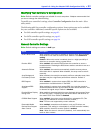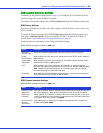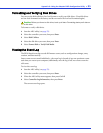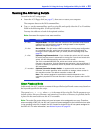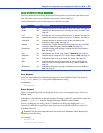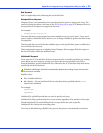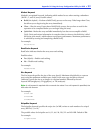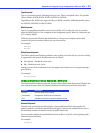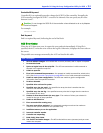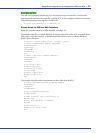
Appendix D: Using the Array Configuration Utility for DOS ● 88
Running the ACU Using Scripts
To work in the ACU using scripts:
1 Insert the ACU floppy disk (see page 87), then start or restart your computer.
The computer boots to the DOS command line.
2 Type
ACU
on the command line, specify a script file, and specify either the /P or /R switches
listed in the following table. (Don’t specify both.)
You may also add one or both of the optional switches.
Note:
Command line syntax is not case sensitive.
About Playback Mode
In this mode, the ACU reads the contents of the specified script file and creates arrays based on
the keywords specified in the script.
The syntax is
ACU /P <file>
where
file
is the name of the script file. The file parameter can
include a drive, directory, filename, and extension. If no drive or directory is specified, the file
is placed in the same location as the ACU executable.
Note:
The script file syntax allows only one hot spare to be assigned to an array. Therefore,
when recording a RAID 10, the ACU can’t map hot spares assigned to the individual mirror sets
in the resulting script file. Instead, the ACU creates a single list for all
hot spares assigned to
the RAID 10. For more information, see
Method Keyword
on page 92
.
Switch Description
/P <file> Playback Mode—The ACU reads the contents of the specified script file and
creates arrays and configures channel settings based on the keywords
defined in the script. See page 88.
/R <file> Record Mode—The ACU writes a RAID controller’s existing array configuration
to a specified script file, which lets you create the same configuration by
running the ACU in playback mode (/P switch) with the resulting script. See
page 89.
/L <file> (Optional) Log Filename Switch—If you include this switch, the ACU records
its activity and any errors it encounters in the log file. If you do not include this
switch, the ACU displays activity and errors on the screen.
The file is a standard MS-DOS file, which can include a drive, directory,
filename, and extension. Only the filename and extension (.log) are required. If
no drive or directory is specified, the file is placed in the same location as the
ACU executable.
/C <number> (Optional) Controller Number Switch—In systems with more than one
controller, this switch specifies which controller to change, where number is
the controller number. The default controller number is 0.
Note—The number assigned to a particular controller depends on the
controller’s physical PCI slot and the order in which your system scans its PCI
slots.





